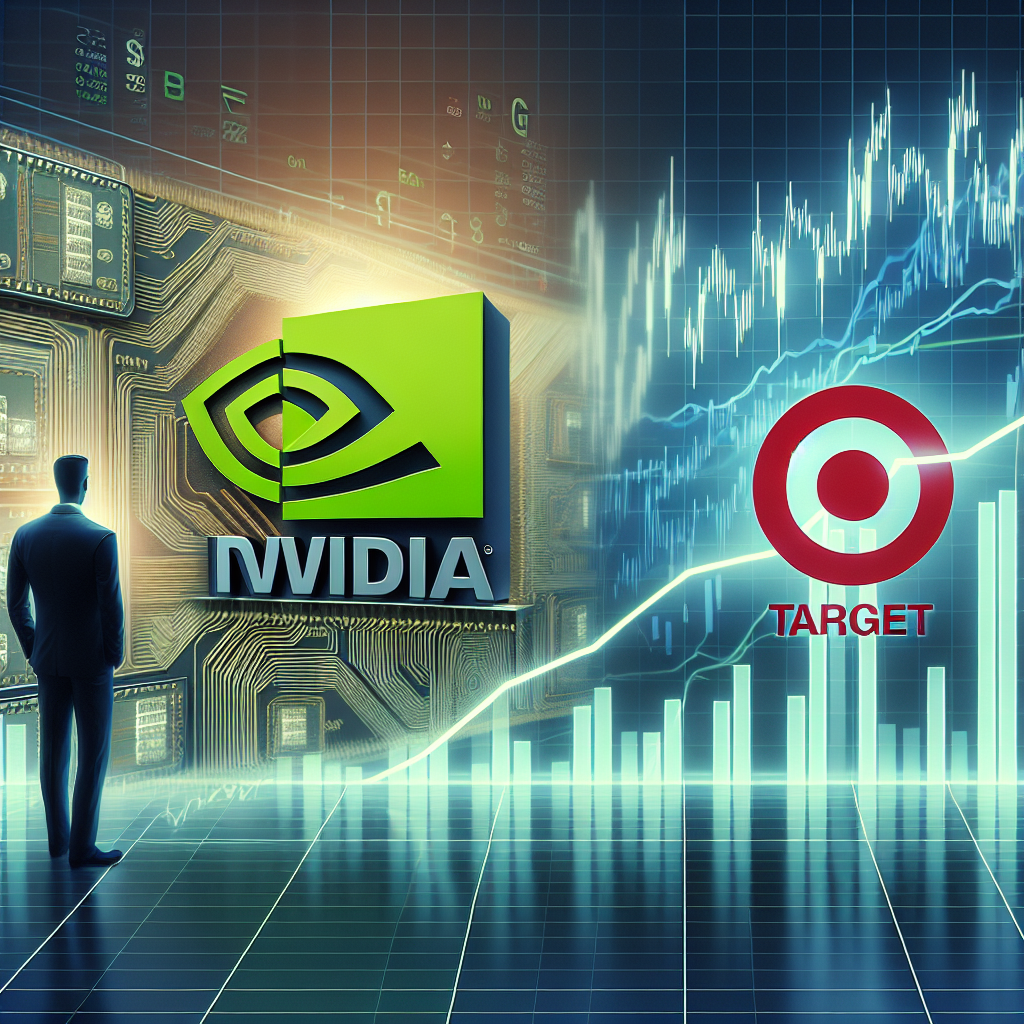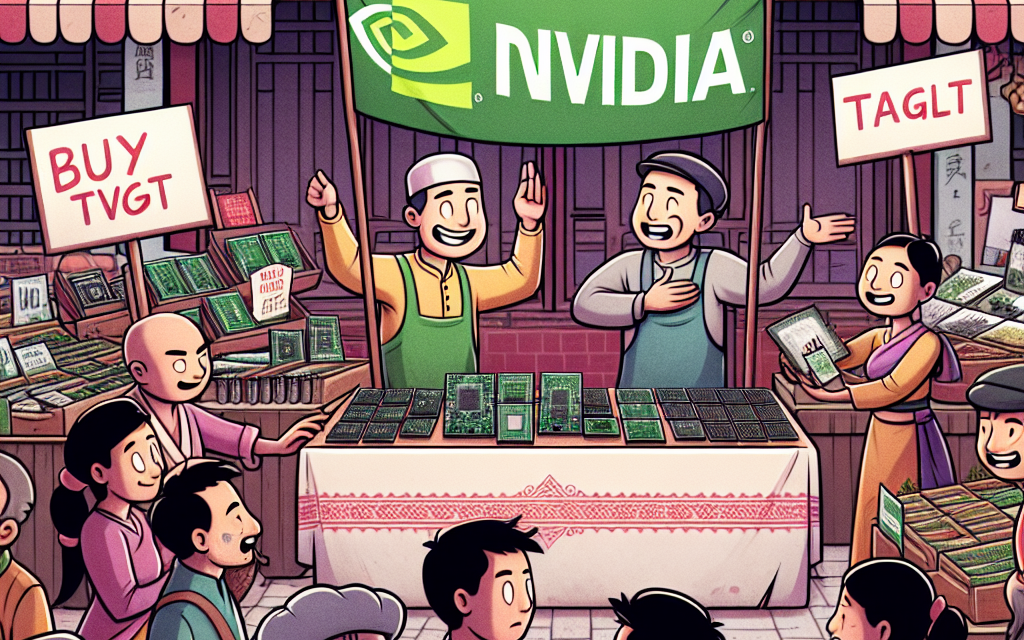“Ride the Tech Wave, Ditch the Retail Drag: This Week’s Strategic Moves”
Introduction
This week’s stock picks focus on strategic moves in the technology and retail sectors, highlighting the potential benefits of buying Nvidia and selling Target. Nvidia, a leader in the semiconductor industry, continues to demonstrate robust growth prospects driven by its dominance in graphics processing units (GPUs) and its expanding influence in artificial intelligence and data centers. The company’s innovative advancements and strong market position make it an attractive buy for investors seeking exposure to cutting-edge technology. Conversely, Target faces challenges amid shifting consumer behaviors and economic pressures, suggesting a potential decline in its stock value. By analyzing market trends and company performance, this week’s picks aim to capitalize on Nvidia’s upward trajectory while mitigating risks associated with Target’s current market position.
Analyzing Nvidia’s Market Position: Why It’s a Buy This Week
In the ever-evolving landscape of technology and retail, investors are constantly seeking opportunities to optimize their portfolios. This week, Nvidia emerges as a compelling buy, while Target presents a case for reconsideration. Nvidia, a leader in the semiconductor industry, has consistently demonstrated its prowess in innovation and market adaptability. The company’s robust performance is underpinned by its strategic positioning in high-growth sectors such as artificial intelligence, gaming, and data centers. As these industries continue to expand, Nvidia’s cutting-edge graphics processing units (GPUs) and related technologies are in high demand, driving revenue growth and enhancing shareholder value.
One of the key factors contributing to Nvidia’s favorable market position is its dominance in the AI sector. The company’s GPUs are integral to machine learning and deep learning applications, which are increasingly being adopted across various industries. This widespread adoption is not only a testament to Nvidia’s technological superiority but also a harbinger of sustained demand for its products. Furthermore, Nvidia’s recent foray into the automotive industry, with its advanced driver-assistance systems (ADAS) and autonomous vehicle technologies, positions it well to capitalize on the burgeoning market for smart vehicles.
In addition to its technological advancements, Nvidia’s strategic acquisitions have bolstered its market position. The acquisition of Mellanox Technologies, for instance, has enhanced Nvidia’s capabilities in high-performance computing and networking, further solidifying its foothold in the data center market. This strategic move has allowed Nvidia to offer comprehensive solutions that cater to the growing needs of cloud computing and enterprise customers. As a result, Nvidia is well-positioned to benefit from the ongoing digital transformation across industries.
While Nvidia’s prospects appear promising, Target’s outlook is less optimistic. The retail giant has been grappling with several challenges that have impacted its performance. One of the primary concerns is the intensifying competition in the retail sector, particularly from e-commerce behemoths like Amazon. Target’s efforts to enhance its online presence and improve its supply chain efficiency have yielded some positive results; however, these initiatives have not been sufficient to offset the pressure from its competitors.
Moreover, Target’s reliance on discretionary spending makes it vulnerable to economic fluctuations. In times of economic uncertainty, consumers tend to prioritize essential goods over non-essential items, which can adversely affect Target’s sales. Additionally, the company’s recent financial results have shown signs of slowing growth, raising concerns about its ability to sustain its current trajectory. These factors, coupled with the broader challenges facing the retail industry, suggest that Target may face headwinds in the near term.
In conclusion, Nvidia’s strong market position, driven by its technological innovations and strategic acquisitions, makes it an attractive buy for investors seeking exposure to high-growth sectors. The company’s ability to adapt to changing market dynamics and capitalize on emerging opportunities underscores its potential for long-term success. Conversely, Target’s challenges in navigating a competitive retail landscape and its vulnerability to economic shifts warrant caution. Investors may find it prudent to reassess their positions in Target, considering the potential risks and uncertainties that lie ahead. As always, thorough research and careful consideration of market trends are essential for making informed investment decisions.
Target’s Recent Performance: Key Reasons to Consider Selling
In recent months, Target Corporation has faced a series of challenges that have raised concerns among investors, prompting some to consider selling their shares. While the retail giant has long been a staple in the industry, recent performance metrics suggest that it may be time to reassess its position in one’s investment portfolio. Several key factors contribute to this perspective, each of which warrants careful consideration.
To begin with, Target’s financial performance has shown signs of strain. The company’s latest earnings report revealed a decline in same-store sales, a critical indicator of retail health. This downturn can be attributed to a combination of factors, including shifting consumer preferences and increased competition from both traditional and online retailers. As consumers increasingly gravitate towards e-commerce platforms, Target has struggled to maintain its market share, despite efforts to bolster its online presence. This trend is particularly concerning given the rapid pace at which the retail landscape is evolving.
Moreover, Target’s profit margins have been under pressure due to rising operational costs. The company has faced increased expenses related to supply chain disruptions, labor shortages, and inflationary pressures. These challenges have not only impacted Target’s bottom line but have also raised questions about its ability to sustain profitability in the long term. As a result, investors are left to ponder whether the company’s current strategies are sufficient to navigate these headwinds effectively.
In addition to financial concerns, Target has encountered reputational challenges that could further impact its performance. Recent controversies surrounding its business practices and corporate governance have drawn scrutiny from both consumers and investors. These issues have the potential to erode consumer trust and loyalty, which are vital components of any successful retail operation. As public perception plays an increasingly significant role in a company’s success, Target must address these concerns promptly to mitigate potential damage.
Furthermore, the competitive landscape in the retail sector has intensified, with major players like Amazon and Walmart continuing to expand their reach and capabilities. These companies have made significant investments in technology and logistics, enabling them to offer more competitive pricing and faster delivery options. In contrast, Target’s efforts to keep pace with these industry leaders have been met with mixed results. While the company has made strides in enhancing its digital offerings, it still faces an uphill battle in capturing a larger share of the online market.
Given these challenges, some investors may find it prudent to reevaluate their holdings in Target. While the company has demonstrated resilience in the past, the current environment presents a unique set of obstacles that could hinder its growth prospects. By considering the broader context of the retail industry and Target’s position within it, investors can make more informed decisions about their portfolios.
In conclusion, while Target has been a reliable performer in the retail sector for many years, recent developments suggest that it may be time to reconsider its place in one’s investment strategy. The combination of financial pressures, reputational challenges, and heightened competition presents a formidable set of hurdles for the company to overcome. As such, investors should carefully weigh these factors when deciding whether to hold or sell their shares in Target. By staying informed and proactive, investors can better navigate the complexities of the current market landscape.
Nvidia’s Growth Potential: A Deep Dive into Future Prospects
Nvidia Corporation, a leading player in the semiconductor industry, has consistently demonstrated its prowess in the realm of graphics processing units (GPUs) and artificial intelligence (AI). As the demand for advanced computing solutions continues to surge, Nvidia’s growth potential appears robust, making it an attractive option for investors. The company’s strategic initiatives and innovative product offerings position it well to capitalize on emerging trends in technology. Consequently, a closer examination of Nvidia’s future prospects reveals a compelling case for investment.
To begin with, Nvidia’s dominance in the GPU market is a significant driver of its growth. GPUs are essential components in various applications, ranging from gaming and data centers to AI and machine learning. Nvidia’s cutting-edge technology and continuous innovation have enabled it to maintain a competitive edge over its rivals. The company’s recent advancements in AI, particularly with its AI-driven chips, have opened new avenues for growth. As industries increasingly adopt AI solutions, Nvidia’s products are likely to see heightened demand, further bolstering its revenue streams.
Moreover, Nvidia’s strategic acquisitions have played a crucial role in enhancing its capabilities and expanding its market reach. The acquisition of Mellanox Technologies, for instance, has strengthened Nvidia’s position in the data center market, allowing it to offer comprehensive solutions that integrate computing, networking, and storage. This move not only diversifies Nvidia’s product portfolio but also positions it to benefit from the growing demand for data center infrastructure, driven by the proliferation of cloud computing and big data analytics.
In addition to its strong market position, Nvidia’s financial performance underscores its growth potential. The company has consistently delivered impressive revenue growth, driven by robust sales across its various segments. Its strong balance sheet and healthy cash flow provide the financial flexibility needed to invest in research and development, ensuring that Nvidia remains at the forefront of technological innovation. Furthermore, Nvidia’s commitment to returning value to shareholders through dividends and share buybacks enhances its appeal as a long-term investment.
Transitioning to the broader market context, the increasing adoption of AI and machine learning across industries presents a significant growth opportunity for Nvidia. From autonomous vehicles to healthcare and finance, AI applications are transforming traditional business models, creating new demand for high-performance computing solutions. Nvidia’s expertise in AI and its comprehensive suite of products position it well to capture a substantial share of this burgeoning market.
However, it is essential to acknowledge potential challenges that Nvidia may face. The semiconductor industry is highly competitive, with rapid technological advancements and evolving consumer preferences. Additionally, geopolitical tensions and supply chain disruptions could impact Nvidia’s operations. Nevertheless, the company’s proactive approach to addressing these challenges, coupled with its strong market position, mitigates these risks to a considerable extent.
In conclusion, Nvidia’s growth potential is underpinned by its leadership in the GPU market, strategic acquisitions, and robust financial performance. The company’s ability to innovate and adapt to emerging trends in technology positions it well for sustained growth. As industries increasingly embrace AI and advanced computing solutions, Nvidia stands to benefit significantly, making it a compelling choice for investors seeking exposure to the technology sector. While challenges exist, Nvidia’s strategic initiatives and market leadership provide a solid foundation for future success, reinforcing the case for buying Nvidia stock.
Target’s Challenges: Understanding the Factors Behind the Sell Recommendation

In the ever-evolving landscape of retail, Target Corporation has long been a stalwart, known for its ability to adapt and thrive amidst changing consumer preferences. However, recent developments have prompted a reevaluation of its stock, leading to a sell recommendation. Understanding the factors behind this decision requires a closer examination of the challenges currently facing the retail giant.
To begin with, Target is grappling with a shifting consumer landscape, where e-commerce continues to gain traction at the expense of traditional brick-and-mortar stores. While Target has made significant strides in enhancing its online presence, it faces stiff competition from e-commerce behemoths like Amazon. This competitive pressure has necessitated substantial investments in digital infrastructure and logistics, which, while essential for long-term growth, have weighed on short-term profitability.
Moreover, the macroeconomic environment presents additional hurdles. Inflationary pressures have led to increased costs for goods and services, squeezing profit margins. Target, like many retailers, is caught in a delicate balancing act of managing rising costs while maintaining competitive pricing to attract price-sensitive consumers. This challenge is compounded by supply chain disruptions, which have become a persistent issue in the post-pandemic world. Delays and shortages have not only affected inventory levels but have also increased operational costs, further impacting the bottom line.
In addition to these external factors, Target is also navigating internal challenges. The company has embarked on an ambitious expansion strategy, opening new stores and remodeling existing ones to enhance the shopping experience. While these initiatives are aimed at driving long-term growth, they require significant capital expenditure, which can strain financial resources in the short term. Furthermore, the success of these initiatives is contingent upon effective execution and consumer reception, both of which carry inherent risks.
Another critical factor influencing the sell recommendation is Target’s recent financial performance. While the company has reported steady revenue growth, its profit margins have come under pressure. The combination of increased operational costs, competitive pricing strategies, and investments in growth initiatives has led to a decline in net income. This trend raises concerns about the company’s ability to sustain profitability in the face of ongoing challenges.
Additionally, Target’s stock valuation plays a crucial role in the sell recommendation. Despite the challenges, the company’s stock has remained relatively resilient, buoyed by investor optimism and broader market trends. However, this resilience has led to a valuation that some analysts consider stretched, particularly when compared to peers facing similar headwinds. As a result, there is a growing sentiment that the stock may be overvalued, prompting a more cautious stance.
In conclusion, while Target remains a formidable player in the retail sector, a confluence of external and internal challenges has led to a reassessment of its stock. The pressures of a competitive e-commerce landscape, inflationary costs, supply chain disruptions, and ambitious expansion plans all contribute to a complex operating environment. Coupled with concerns about profitability and valuation, these factors underpin the sell recommendation. Investors are advised to carefully consider these dynamics when evaluating their positions in Target, as the company navigates this challenging period.
Nvidia’s Technological Innovations: How They Drive Stock Value
Nvidia Corporation, a leading player in the technology sector, has consistently demonstrated its prowess in innovation, which in turn has significantly driven its stock value. As investors seek opportunities in the ever-evolving tech landscape, Nvidia stands out due to its cutting-edge advancements and strategic positioning in key growth areas. The company’s focus on artificial intelligence (AI), gaming, and data centers has not only solidified its market presence but also enhanced its appeal to investors looking for robust growth potential.
To begin with, Nvidia’s advancements in AI have been a major catalyst for its stock performance. The company’s GPUs (graphics processing units) are widely recognized for their superior capabilities in handling complex computations, making them indispensable in AI applications. Nvidia’s CUDA platform, which allows developers to harness the power of GPUs for general-purpose computing, has become a cornerstone in AI research and development. This technological edge has enabled Nvidia to capture a significant share of the AI market, which is projected to grow exponentially in the coming years. As AI continues to permeate various industries, from healthcare to autonomous vehicles, Nvidia’s role as a key enabler of this technology positions it favorably for sustained stock appreciation.
Moreover, Nvidia’s dominance in the gaming industry further bolsters its stock value. The company’s GeForce GPUs are the gold standard for gaming enthusiasts, offering unparalleled performance and visual fidelity. With the gaming industry experiencing a surge in demand, partly fueled by the rise of eSports and the increasing popularity of virtual reality (VR), Nvidia is well-positioned to capitalize on these trends. The launch of its RTX series, which introduced real-time ray tracing capabilities, has set a new benchmark for gaming graphics, reinforcing Nvidia’s leadership in this lucrative market. Consequently, the company’s strong foothold in gaming continues to be a significant driver of its stock’s upward trajectory.
In addition to AI and gaming, Nvidia’s strategic investments in data centers have also contributed to its stock’s robust performance. As the demand for cloud computing and data storage solutions grows, Nvidia’s data center business has emerged as a key growth engine. The company’s GPUs are increasingly being used in data centers to accelerate workloads, improve efficiency, and reduce operational costs. This has led to a surge in demand for Nvidia’s products from major cloud service providers and enterprises seeking to enhance their data processing capabilities. As a result, Nvidia’s data center revenue has witnessed substantial growth, further underpinning its stock value.
Furthermore, Nvidia’s commitment to research and development ensures that it remains at the forefront of technological innovation. The company’s substantial investment in R&D not only drives product enhancements but also fosters the development of new technologies that can open up additional revenue streams. This forward-thinking approach not only strengthens Nvidia’s competitive advantage but also instills confidence in investors regarding the company’s long-term growth prospects.
In conclusion, Nvidia’s technological innovations across AI, gaming, and data centers have been instrumental in driving its stock value. The company’s strategic focus on these high-growth areas, coupled with its commitment to innovation, positions it as a compelling investment opportunity. As Nvidia continues to push the boundaries of technology, its stock is likely to remain an attractive choice for investors seeking exposure to the dynamic tech sector.
Target’s Competitive Landscape: What Makes It a Sell Opportunity
In the ever-evolving world of retail, Target Corporation has long been a stalwart, known for its ability to blend affordability with a touch of style. However, recent shifts in the competitive landscape suggest that Target may be facing challenges that could impact its stock performance. As investors seek to optimize their portfolios, understanding the dynamics at play in Target’s market environment is crucial.
To begin with, the retail sector is undergoing significant transformation, driven by technological advancements and changing consumer preferences. E-commerce giants like Amazon have set new standards for convenience and speed, compelling traditional retailers to adapt or risk obsolescence. Target, while having made strides in its digital offerings, still finds itself in a fierce battle to capture the online market share. Despite its efforts to enhance its e-commerce platform, Target’s digital sales growth has not kept pace with some of its competitors, raising concerns about its ability to thrive in an increasingly digital-first world.
Moreover, the competitive pressure is not limited to the digital realm. Brick-and-mortar competitors, such as Walmart, continue to pose a formidable challenge. Walmart’s extensive network of stores, coupled with its aggressive pricing strategies, has allowed it to maintain a strong foothold in the retail market. Target, on the other hand, has struggled to match Walmart’s scale and pricing power, which could potentially erode its market share over time. This competitive disadvantage is further exacerbated by the rising costs associated with supply chain disruptions and inflationary pressures, which have squeezed profit margins across the retail sector.
In addition to these external pressures, Target faces internal challenges that could hinder its growth prospects. The company’s recent financial performance has shown signs of strain, with declining same-store sales and shrinking profit margins. These indicators suggest that Target may be struggling to maintain its competitive edge, particularly in a market where consumers are becoming increasingly price-sensitive. Furthermore, Target’s heavy reliance on discretionary spending categories, such as apparel and home goods, makes it vulnerable to economic downturns, as consumers tend to cut back on non-essential purchases during times of financial uncertainty.
While Target has made efforts to diversify its product offerings and enhance its customer experience, these initiatives may not be sufficient to offset the broader challenges it faces. The company’s strategic focus on expanding its private label brands and enhancing its in-store experience, while commendable, may not be enough to counteract the competitive pressures from both digital and traditional retail giants. As a result, investors may view Target as a less attractive investment opportunity compared to other players in the retail sector.
In conclusion, while Target has been a reliable performer in the past, the current competitive landscape presents significant challenges that could impact its future growth prospects. The combination of intense competition from both e-commerce and brick-and-mortar retailers, coupled with internal financial pressures, suggests that Target may struggle to maintain its market position. For investors seeking to optimize their portfolios, these factors make Target a potential sell opportunity, as the company navigates an increasingly complex and competitive retail environment.
Expert Insights: Balancing Nvidia Buys with Target Sells in Your Portfolio
In the ever-evolving landscape of the stock market, making informed decisions is crucial for investors seeking to optimize their portfolios. This week, expert insights suggest a strategic approach: buying Nvidia while selling Target. This recommendation is grounded in a careful analysis of market trends, company performance, and future growth potential, offering a balanced perspective for investors aiming to navigate the complexities of the current economic environment.
Nvidia, a leading player in the technology sector, has consistently demonstrated robust growth, driven by its innovative advancements in graphics processing units (GPUs) and artificial intelligence (AI) technologies. The company’s strong foothold in these high-demand areas positions it well for continued success. As the world increasingly relies on digital solutions, Nvidia’s products are integral to a wide range of applications, from gaming to data centers and autonomous vehicles. This diversification not only enhances Nvidia’s revenue streams but also mitigates risks associated with market fluctuations in any single sector. Furthermore, Nvidia’s strategic acquisitions and partnerships have bolstered its competitive edge, making it a compelling buy for investors seeking long-term growth.
In contrast, Target, a major player in the retail sector, faces a different set of challenges. While the company has shown resilience in adapting to changing consumer behaviors, it is not immune to the broader economic pressures impacting the retail industry. Rising inflation and supply chain disruptions have exerted pressure on profit margins, and consumer spending patterns remain unpredictable. Although Target has made significant investments in e-commerce and same-day delivery services, these efforts may not be sufficient to offset the headwinds it faces. Consequently, selling Target shares could be a prudent move for investors looking to reallocate resources to sectors with more promising growth trajectories.
Transitioning from the specifics of these two companies to broader market considerations, it is essential to recognize the importance of diversification in an investment portfolio. By balancing investments in technology stocks like Nvidia with strategic divestments from retail stocks such as Target, investors can better position themselves to weather market volatility. This approach not only capitalizes on the growth potential of technology but also reduces exposure to sectors that may be more vulnerable to economic downturns.
Moreover, the current macroeconomic environment underscores the need for such strategic adjustments. With interest rates fluctuating and geopolitical tensions influencing global markets, investors must remain vigilant and adaptable. By staying informed about industry trends and company performance, they can make decisions that align with their financial goals and risk tolerance.
In conclusion, the recommendation to buy Nvidia and sell Target reflects a nuanced understanding of market dynamics and company-specific factors. Nvidia’s strong growth prospects and strategic positioning in the technology sector make it an attractive option for investors seeking to enhance their portfolios. Meanwhile, the challenges facing Target highlight the importance of reassessing investments in the retail sector. By considering these expert insights and maintaining a diversified portfolio, investors can navigate the complexities of the stock market with greater confidence and foresight.
Q&A
1. **Question:** Why is Nvidia considered a good buy this week?
**Answer:** Nvidia is considered a good buy due to its strong performance in the AI and semiconductor sectors, robust earnings reports, and positive market sentiment.
2. **Question:** What factors are influencing the decision to sell Target stock?
**Answer:** Target stock is being sold due to concerns over declining retail sales, supply chain issues, and increased competition affecting its profitability.
3. **Question:** How has Nvidia’s stock performance been recently?
**Answer:** Nvidia’s stock has shown significant growth, driven by high demand for its GPUs and advancements in AI technology.
4. **Question:** What are the potential risks of buying Nvidia stock?
**Answer:** Potential risks include market volatility, regulatory challenges, and dependency on the cyclical semiconductor industry.
5. **Question:** What recent developments have negatively impacted Target’s stock?
**Answer:** Recent developments include disappointing earnings forecasts, inventory management issues, and economic pressures on consumer spending.
6. **Question:** Are there any upcoming events that could affect Nvidia’s stock price?
**Answer:** Upcoming events include product launches, earnings reports, and industry conferences that could influence investor sentiment.
7. **Question:** What is the overall market sentiment towards Target stock?
**Answer:** The overall market sentiment towards Target stock is cautious, with analysts expressing concerns over its ability to navigate current retail challenges.
Conclusion
Nvidia has shown strong growth potential due to its leadership in the semiconductor industry, particularly in AI and gaming technologies, making it an attractive buy for investors seeking exposure to these high-demand sectors. Conversely, Target faces challenges such as increased competition and shifting consumer preferences, which may impact its profitability and growth prospects, suggesting a sell recommendation for those looking to optimize their portfolio performance this week.





